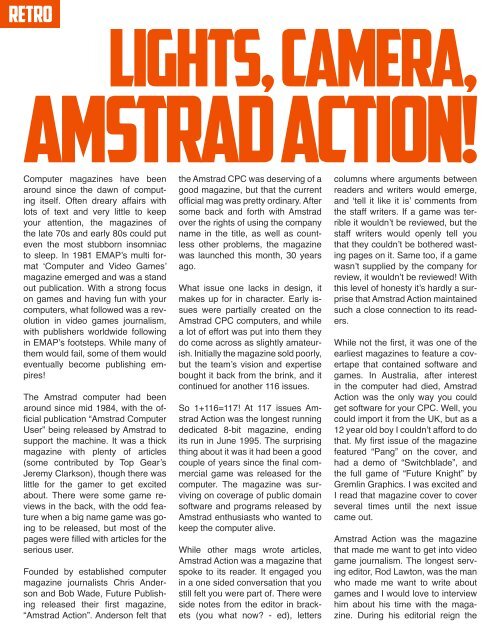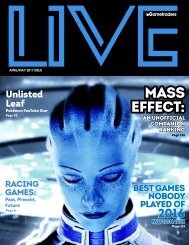October Magazine
Horror time ... if you love horror games, comics and cosplay, you'll love this months issue of Live Magazine!
Horror time ... if you love horror games, comics and cosplay, you'll love this months issue of Live Magazine!
Create successful ePaper yourself
Turn your PDF publications into a flip-book with our unique Google optimized e-Paper software.
etro<br />
Lights, Camera,<br />
Amstrad Action!<br />
Computer magazines have been<br />
around since the dawn of computing<br />
itself. Often dreary affairs with<br />
lots of text and very little to keep<br />
your attention, the magazines of<br />
the late 70s and early 80s could put<br />
even the most stubborn insomniac<br />
to sleep. In 1981 EMAP’s multi format<br />
‘Computer and Video Games’<br />
magazine emerged and was a stand<br />
out publication. With a strong focus<br />
on games and having fun with your<br />
computers, what followed was a revolution<br />
in video games journalism,<br />
with publishers worldwide following<br />
in EMAP’s footsteps. While many of<br />
them would fail, some of them would<br />
eventually become publishing empires!<br />
The Amstrad computer had been<br />
around since mid 1984, with the official<br />
publication “Amstrad Computer<br />
User” being released by Amstrad to<br />
support the machine. It was a thick<br />
magazine with plenty of articles<br />
(some contributed by Top Gear’s<br />
Jeremy Clarkson), though there was<br />
little for the gamer to get excited<br />
about. There were some game reviews<br />
in the back, with the odd feature<br />
when a big name game was going<br />
to be released, but most of the<br />
pages were filled with articles for the<br />
serious user.<br />
Founded by established computer<br />
magazine journalists Chris Anderson<br />
and Bob Wade, Future Publishing<br />
released their first magazine,<br />
“Amstrad Action”. Anderson felt that<br />
the Amstrad CPC was deserving of a<br />
good magazine, but that the current<br />
official mag was pretty ordinary. After<br />
some back and forth with Amstrad<br />
over the rights of using the company<br />
name in the title, as well as countless<br />
other problems, the magazine<br />
was launched this month, 30 years<br />
ago.<br />
What issue one lacks in design, it<br />
makes up for in character. Early issues<br />
were partially created on the<br />
Amstrad CPC computers, and while<br />
a lot of effort was put into them they<br />
do come across as slightly amateurish.<br />
Initially the magazine sold poorly,<br />
but the team’s vision and expertise<br />
bought it back from the brink, and it<br />
continued for another 116 issues.<br />
So 1+116=117! At 117 issues Amstrad<br />
Action was the longest running<br />
dedicated 8-bit magazine, ending<br />
its run in June 1995. The surprising<br />
thing about it was it had been a good<br />
couple of years since the final commercial<br />
game was released for the<br />
computer. The magazine was surviving<br />
on coverage of public domain<br />
software and programs released by<br />
Amstrad enthusiasts who wanted to<br />
keep the computer alive.<br />
While other mags wrote articles,<br />
Amstrad Action was a magazine that<br />
spoke to its reader. It engaged you<br />
in a one sided conversation that you<br />
still felt you were part of. There were<br />
side notes from the editor in brackets<br />
(you what now? - ed), letters<br />
columns where arguments between<br />
readers and writers would emerge,<br />
and ‘tell it like it is’ comments from<br />
the staff writers. If a game was terrible<br />
it wouldn’t be reviewed, but the<br />
staff writers would openly tell you<br />
that they couldn’t be bothered wasting<br />
pages on it. Same too, if a game<br />
wasn’t supplied by the company for<br />
review, it wouldn’t be reviewed! With<br />
this level of honesty it’s hardly a surprise<br />
that Amstrad Action maintained<br />
such a close connection to its readers.<br />
While not the first, it was one of the<br />
earliest magazines to feature a covertape<br />
that contained software and<br />
games. In Australia, after interest<br />
in the computer had died, Amstrad<br />
Action was the only way you could<br />
get software for your CPC. Well, you<br />
could import it from the UK, but as a<br />
12 year old boy I couldn’t afford to do<br />
that. My first issue of the magazine<br />
featured “Pang” on the cover, and<br />
had a demo of “Switchblade”, and<br />
the full game of “Future Knight” by<br />
Gremlin Graphics. I was excited and<br />
I read that magazine cover to cover<br />
several times until the next issue<br />
came out.<br />
Amstrad Action was the magazine<br />
that made me want to get into video<br />
game journalism. The longest serving<br />
editor, Rod Lawton, was the man<br />
who made me want to write about<br />
games and I would love to interview<br />
him about his time with the magazine.<br />
During his editorial reign the


















